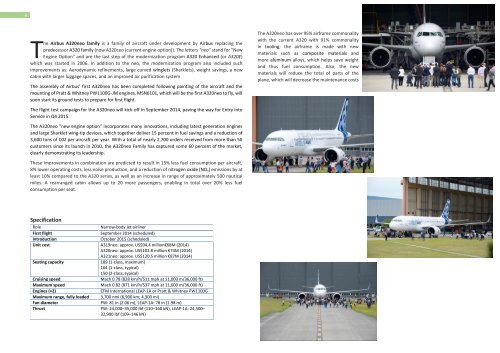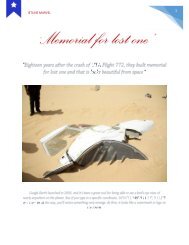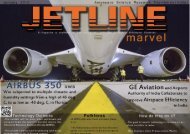Jetline marvel
This first issue is the beginning of our long journey which packed with striking Aviation reports , airlines reviews , articles,stories and most of all phenomenal imagery by reports from all over the globe about aviation & aerospace enthusiast people. Jetline Marvel is Synchronized by Aerospace Science Research Foundation(India) as well as Aerospace Science Club, Bengaluru.
This first issue is the beginning of our long journey which packed with striking Aviation reports , airlines reviews , articles,stories and most of all phenomenal imagery by reports from all over the globe about aviation & aerospace enthusiast people. Jetline Marvel is Synchronized by Aerospace Science Research Foundation(India) as well as Aerospace Science Club, Bengaluru.
Create successful ePaper yourself
Turn your PDF publications into a flip-book with our unique Google optimized e-Paper software.
6<br />
JETLINE <strong>marvel</strong> I January 2015<br />
T<br />
he Airbus A320neo family is a family of aircraft under development by Airbus replacing the<br />
predecessor A320 family (now A320ceo (current engine option)). The letters "neo" stand for "New<br />
Engine Option" and are the last step of the modernization program A320 Enhanced (or A320E)<br />
which was started in 2006. In addition to the neo, the modernization program also included such<br />
improvements as: Aerodynamic refinements, large curved winglets (Sharklets), weight savings, a new<br />
cabin with larger luggage spaces, and an improved air purification system<br />
The assembly of Airbus’ first A320neo has been completed following painting of the aircraft and the<br />
mounting of Pratt & Whitney PW1100G-JM engines. MSN6101, which will be the first A320neo to fly, will<br />
soon start its ground tests to prepare for first flight.<br />
The A320neo has over 95% airframe commonality<br />
with the current A320 with 91% commonality<br />
in tooling; the airframe is made with new<br />
materials such as composite materials and<br />
more aluminum alloys, which helps save weight<br />
and thus fuel consumption. Also, the new<br />
materials will reduce the total of parts of the<br />
plane, which will decrease the maintenance costs<br />
The flight test campaign for the A320neo will kick-off in September 2014, paving the way for Entry into<br />
Service in Q4 2015.<br />
The A320neo “new engine option” incorporates many innovations, including latest generation engines<br />
and large Sharklet wing-tip devices, which together deliver 15 percent in fuel savings and a reduction of<br />
3,600 tons of C02 per aircraft per year. With a total of nearly 2,700 orders received from more than 50<br />
customers since its launch in 2010, the A320neo Family has captured some 60 percent of the market,<br />
clearly demonstrating its leadership.<br />
These improvements in combination are predicted to result in 15% less fuel consumption per aircraft,<br />
8% lower operating costs, less noise production, and a reduction of nitrogen oxide (NOx) emissions by at<br />
least 10% compared to the A320 series, as well as an increase in range of approximately 500 nautical<br />
miles. A rearranged cabin allows up to 20 more passengers, enabling in total over 20% less fuel<br />
consumption per seat.<br />
Specification<br />
Role<br />
Narrow-body jet airliner<br />
First flight<br />
September 2014 (scheduled)<br />
Introduction<br />
October 2015 (scheduled)<br />
Unit cost A319neo: approx. US$94.4 million€68M (2014)<br />
A320neo: approx. US$102.8 million €74M (2014)<br />
A321neo: approx. US$120.5 million €87M (2014)<br />
Seating capacity<br />
189 (1-class, maximum)<br />
164 (1-class, typical)<br />
150 (2-class, typical)<br />
Cruising speed<br />
Mach 0.78 (828 km/h/511 mph at 11,000 m/36,000 ft)<br />
Maximum speed<br />
Mach 0.82 (871 km/h/537 mph at 11,000 m/36,000 ft)<br />
Engines (×2)<br />
CFM International LEAP-1A or Pratt & Whitney PW1100G<br />
Maximum range, fully loaded 3,700 nmi (6,900 km; 4,300 mi)<br />
Fan diameter PW: 81 in (2.06 m), LEAP-1A: 78 in (1.98 m)<br />
Thrust PW: 24,000–35,000 lbf (110–160 kN), LEAP-1A: 24,500–<br />
32,900 lbf (109–146 kN)






